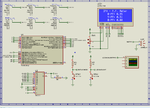baileychic
Advanced Member level 3
My question is 3 PH Power Factor Meter Designing Related. I am using PIC18F26K22 and have completed the coding part. I want to know how I can design the ZCD interface circuit. I am designing the Power factor meter for a client. Client is using 3x 100:5 C.T.
Load will be a 3 PH motor which draws max 15 Amps.
So, C.T. secondary current for 15 Amps input will be 750mA.
I am planning to use simple one resistor and two 1N4148 or 1N4007 diodes for the ZCD circuit. The upper diode cathode is connected to +5.0V and lower diode anode is connected to GND.
To get say 10V from C.T. output I have to use 13.34R or approx 15R but problem is power dissipation in resistor.
Pr = 0.75 * 0.75 *15 = 8.4W.
So, should I use capacitor and resistor in series for the burden so that there will be some reactance and not much power is dissipated in burden resistor ?
Find the attached Proteus simulation of the project.
I am using 1x 440V to 9-0-9V 1A transformer to get 5V power supply and R-V-ZC. I am using 2x 440V to 9V 250mA transformer to get Y-V-ZC and B-V-ZC signals.
Problem is with burdern resistor value.
Load will be a 3 PH motor which draws max 15 Amps.
So, C.T. secondary current for 15 Amps input will be 750mA.
I am planning to use simple one resistor and two 1N4148 or 1N4007 diodes for the ZCD circuit. The upper diode cathode is connected to +5.0V and lower diode anode is connected to GND.
To get say 10V from C.T. output I have to use 13.34R or approx 15R but problem is power dissipation in resistor.
Pr = 0.75 * 0.75 *15 = 8.4W.
So, should I use capacitor and resistor in series for the burden so that there will be some reactance and not much power is dissipated in burden resistor ?
Find the attached Proteus simulation of the project.
I am using 1x 440V to 9-0-9V 1A transformer to get 5V power supply and R-V-ZC. I am using 2x 440V to 9V 250mA transformer to get Y-V-ZC and B-V-ZC signals.
Problem is with burdern resistor value.
Attachments
Last edited:

